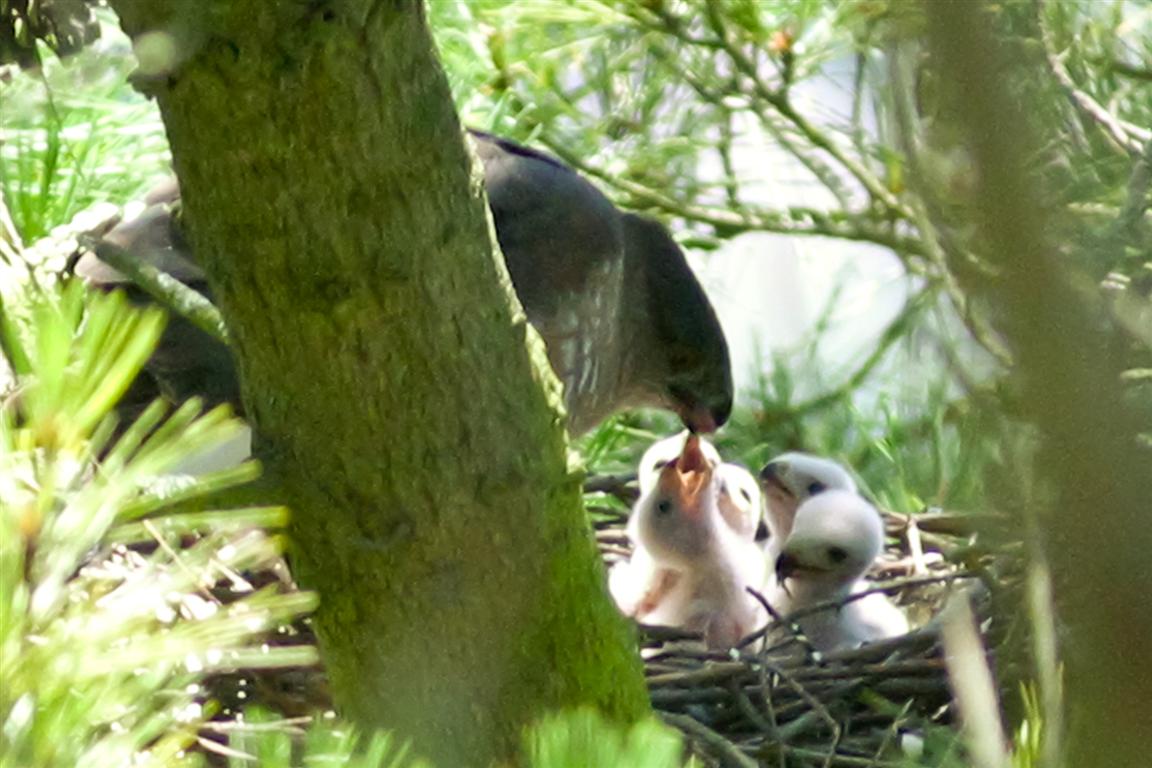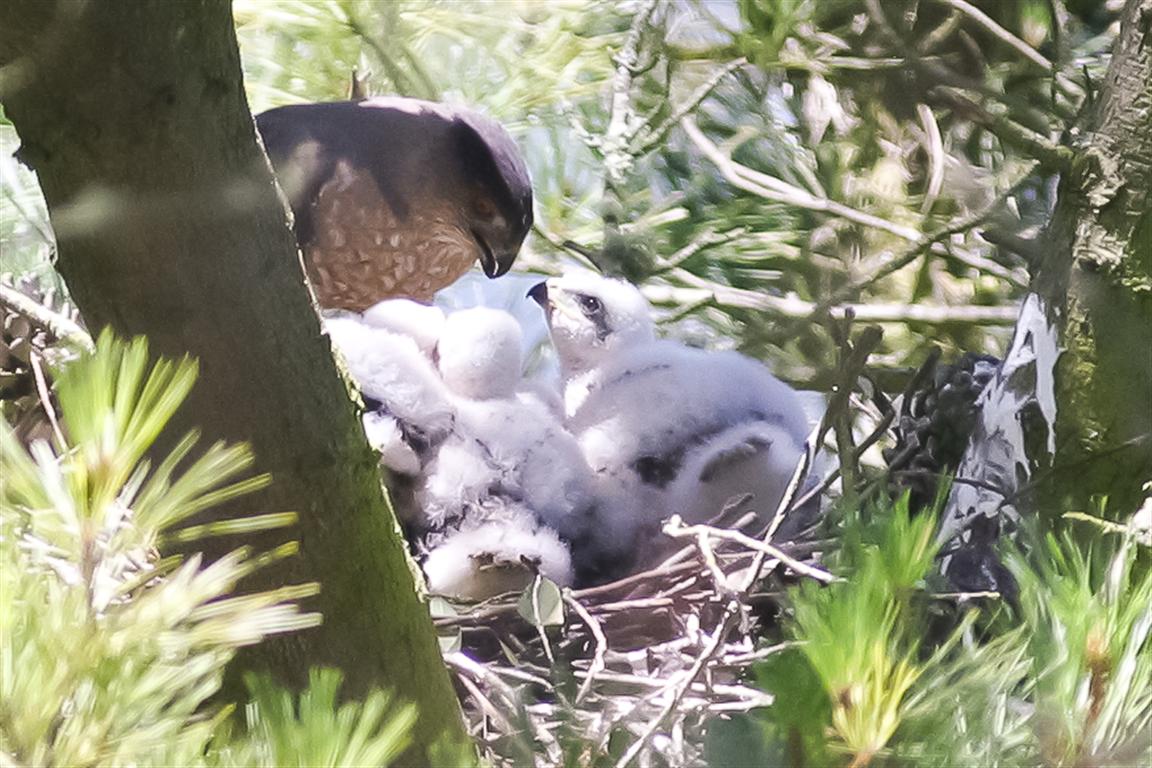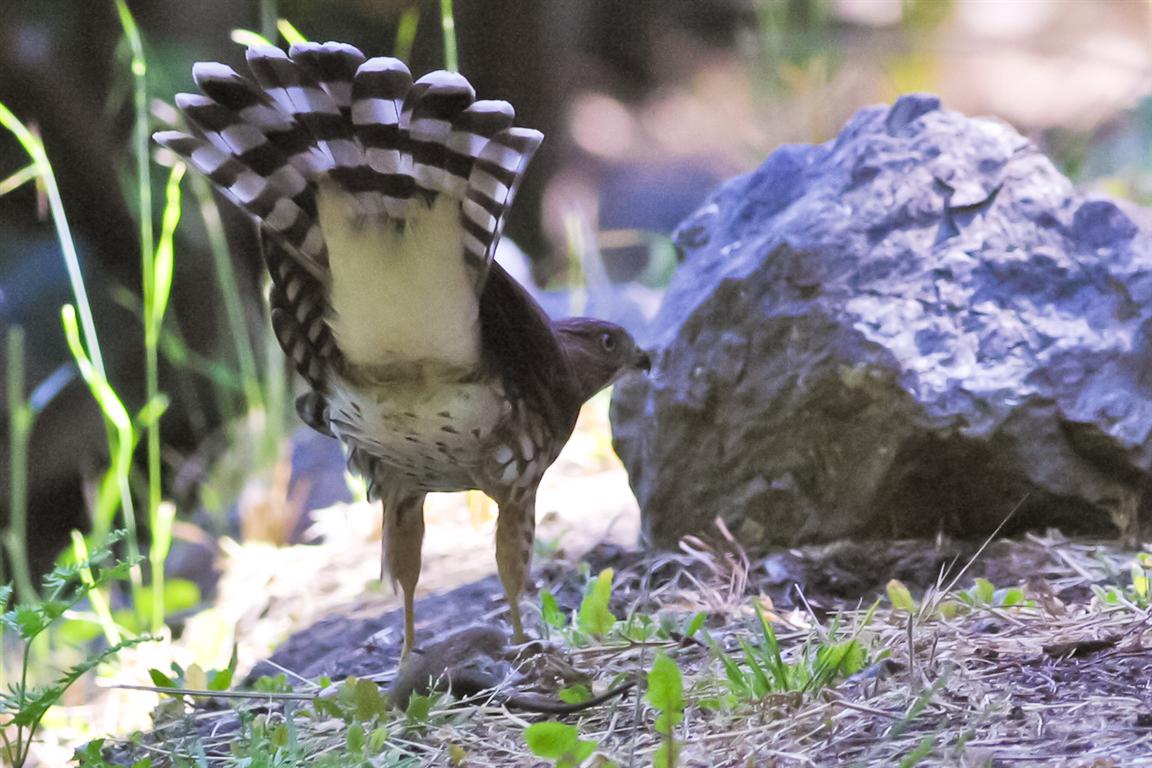City Birds
Urban birds of prey are gifts. They reduce rats and gophers without poisons. They remind us of the intricate, operating ecosystems we live within. A pair of Cooper’s hawks lives in your neighborhood only because the habitat, nest tree, prey, and lack of human disturbance are all there to support them. Raptors are inspiring. For kids and adults, the unpredictable glimpse of a rising red-tailed hawk or a dusk-cruising barn owl may be startling, thought-provoking, uplifting, exciting, or all of the above at once. The charisma and mystery of a hawk or owl tends to leave us a little changed for having crossed their path.
 In 2002, my longtime colleague Ralph Pericoli called to my attention that there were a lot of Cooper’s hawks in our neighborhood of Berkeley, California. Ralph and others were monitoring many of them as part of the Golden Gate Raptor Observatory’s Bay Area Raptor Nesting Study. But Ralph and I conspired to take the study in a new direction—we wanted to conduct an intensive, check-every-tree-for-nests approach to finding all the Cooper’s hawks nesting in a very small geographic area. This would allow us to learn both the annual chick numbers and the density of Cooper’s hawk nests in our neighborhood. We selected the most urban parts of Berkeley and Albany, CA, a roughly rectangular study area, 3.6 x 2.9 miles. We invited experienced GGRO volunteers to meet with us one Sunday afternoon at a small café in Berkeley, expecting five people. Twenty-five showed up! So after moving our meeting to a local schoolyard, we divvied up the nearly 6,900-acre study area into 24 sections, trained people to find Cooper’s nests, and got down to searching.
In 2002, my longtime colleague Ralph Pericoli called to my attention that there were a lot of Cooper’s hawks in our neighborhood of Berkeley, California. Ralph and others were monitoring many of them as part of the Golden Gate Raptor Observatory’s Bay Area Raptor Nesting Study. But Ralph and I conspired to take the study in a new direction—we wanted to conduct an intensive, check-every-tree-for-nests approach to finding all the Cooper’s hawks nesting in a very small geographic area. This would allow us to learn both the annual chick numbers and the density of Cooper’s hawk nests in our neighborhood. We selected the most urban parts of Berkeley and Albany, CA, a roughly rectangular study area, 3.6 x 2.9 miles. We invited experienced GGRO volunteers to meet with us one Sunday afternoon at a small café in Berkeley, expecting five people. Twenty-five showed up! So after moving our meeting to a local schoolyard, we divvied up the nearly 6,900-acre study area into 24 sections, trained people to find Cooper’s nests, and got down to searching.
 Cooper’s hawks are forest raptors, secretive and almost cat-like. They are often portrayed as bird-hunting specialists; however they are known to take up to 30% mammals and reptiles as well. While we were getting started, Ralph and I were motivated by wanting to add to a national knowledge of burgeoning Cooper’s hawks in urban zones. In spite of having spent most of the 1960s-1970s on various “special concern” and “blue-lists” for being nearly endangered, Cooper’s Hawks in the 1990s-2000s seemed to be on an upward growth curve.
Cooper’s hawks are forest raptors, secretive and almost cat-like. They are often portrayed as bird-hunting specialists; however they are known to take up to 30% mammals and reptiles as well. While we were getting started, Ralph and I were motivated by wanting to add to a national knowledge of burgeoning Cooper’s hawks in urban zones. In spite of having spent most of the 1960s-1970s on various “special concern” and “blue-lists” for being nearly endangered, Cooper’s Hawks in the 1990s-2000s seemed to be on an upward growth curve.
Why were they increasing? Why had they declined earlier? No one knows, exactly, but DDT use in the 1950s was documented as a problem for Cooper’s. Also, given their size and some predilection for birds, Cooper’s hawks tended to be singled out as “chicken hawks,” which made them targets for guilt-free shooting both by farmers and pigeon-fanciers. But by the late 1990s, many of these persecutions of Cooper’s seemed to be subsiding, and serious urban studies were becoming established in Stevens Point, Wisconsin; Tucson, Arizona; Vancouver, British Columbia; and Terre Haute, Indiana. So, what did we learn in our 9-year study (2002-2010) of Berkeley Cooper’s hawks? More than can be presented here, but here are some of the highlights.
Successful Cooper’s nests numbered from 5 to 14 per year (successful meaning that a nest produced at least one young). The year we had 14 nests gave us about 1 pair for every 500 acres, which is one of the densest Cooper’s hawk nesting areas yet documented. More interesting to me was how neatly spaced the nests were. Distances between nests tended to be from a 1/4 mile to a ½ mile, and we could often predict where a nest would be because there would be too big of a space between nests. How did the hawks measure the space between nests? Presumably by territorial behaviors, but this is one of many aspects of our study that would be fun to figure out.
 Our counts of “branching” chicks averaged about 3.2 to 4.2 chicks per nest, meaning Berkeley had an exceptionally successful branching rate compared to other studies. Of course we had no idea how well the young Cooper’s hawks survived their first year of life, which is the toughest time in life for all birds of prey. Given the total number of nests and the high potential fledging rate of Cooper’s hawks (some nests fledged 5 young!), the total number of new Cooper’s hawks chicks flying around our 10-square mile study area could be as high as 50 each July. This brings me to a final point. At least three chicks and one adult hawk were documented as having been killed by rat poisons during the study. This was the single biggest cause of hawk mortality that we documented, with young hawks hungrier and not as wary as their adult counterparts. Imagine a newly flying Cooper’s hawk encountering a thirsty, hemorrhaging, poisoned rat in someone’s back yard. After making an easy kill, the hawk consumes the rat and the poison transfers to the raptor. Depending on the dose, within days the hawk may be dead, or it will drown itself trying to overcome the symptom of thirst caused by the anticoagulant rat poison.
Our counts of “branching” chicks averaged about 3.2 to 4.2 chicks per nest, meaning Berkeley had an exceptionally successful branching rate compared to other studies. Of course we had no idea how well the young Cooper’s hawks survived their first year of life, which is the toughest time in life for all birds of prey. Given the total number of nests and the high potential fledging rate of Cooper’s hawks (some nests fledged 5 young!), the total number of new Cooper’s hawks chicks flying around our 10-square mile study area could be as high as 50 each July. This brings me to a final point. At least three chicks and one adult hawk were documented as having been killed by rat poisons during the study. This was the single biggest cause of hawk mortality that we documented, with young hawks hungrier and not as wary as their adult counterparts. Imagine a newly flying Cooper’s hawk encountering a thirsty, hemorrhaging, poisoned rat in someone’s back yard. After making an easy kill, the hawk consumes the rat and the poison transfers to the raptor. Depending on the dose, within days the hawk may be dead, or it will drown itself trying to overcome the symptom of thirst caused by the anticoagulant rat poison.
 There is much more to say about urban Cooper’s hawks and urban raptors in general. The most important notion may be that although urban life may have some benefits to raptors (for example fewer wildlife predators; regular sources of food), it also has some costs (more likely collisions with windows, buildings, and cars; and more poisons of certain kinds). Seeing an urban bird of prey can be a wonderful and inspiring event for any of us, but we each bear some responsibility for giving these urban birds as good a shot at survival by learning about their lives, and by keeping our urban lands free from poisons. The GGRO Cooper’s Hawk Study was made possible by the great and professional dedication of coordinator Ralph Pericoli, who contributed 500-700 hours each spring and summer for nine years. Great thanks also belong to our more than 3 dozen volunteer nest searchers, some of whom stayed with us for the full study. Finally, I would like to dedicate this article to the memory of one of our most ardent volunteers, the late Jennie Rhine, an Alameda County Superior Court Judge who valued urban raptors just as she spoke up for Native American rights and social justice.
There is much more to say about urban Cooper’s hawks and urban raptors in general. The most important notion may be that although urban life may have some benefits to raptors (for example fewer wildlife predators; regular sources of food), it also has some costs (more likely collisions with windows, buildings, and cars; and more poisons of certain kinds). Seeing an urban bird of prey can be a wonderful and inspiring event for any of us, but we each bear some responsibility for giving these urban birds as good a shot at survival by learning about their lives, and by keeping our urban lands free from poisons. The GGRO Cooper’s Hawk Study was made possible by the great and professional dedication of coordinator Ralph Pericoli, who contributed 500-700 hours each spring and summer for nine years. Great thanks also belong to our more than 3 dozen volunteer nest searchers, some of whom stayed with us for the full study. Finally, I would like to dedicate this article to the memory of one of our most ardent volunteers, the late Jennie Rhine, an Alameda County Superior Court Judge who valued urban raptors just as she spoke up for Native American rights and social justice.
Allen Fish is Director of the Golden Gate Raptor Observatory and Co-Founder of RATS. All photos on this page courtesy Tony Brake.
 Trespass grow sites on federal forest land are often patrolled by armed guards, so Mourad and his colleagues can go out only when accompanied by law enforcement. In July, the Humboldt County Sheriff’s Office, the Campaign Against Marijuana Planting, and the US Forest Service confiscated 3,760 marijuana plants. Accompanying these teams, a Hoopa Tribe wildlife ecologist, Mourad, and his colleagues discovered and removed 24 pounds of rodenticides from this remote site near the South Fork of the Trinity River. They also found that the freshwater springs on the site, which feed into the river—home to Coho salmon, Chinook salmon, steelhead, and other struggling fish species—had been diverted to water the pot plants.
Trespass grow sites on federal forest land are often patrolled by armed guards, so Mourad and his colleagues can go out only when accompanied by law enforcement. In July, the Humboldt County Sheriff’s Office, the Campaign Against Marijuana Planting, and the US Forest Service confiscated 3,760 marijuana plants. Accompanying these teams, a Hoopa Tribe wildlife ecologist, Mourad, and his colleagues discovered and removed 24 pounds of rodenticides from this remote site near the South Fork of the Trinity River. They also found that the freshwater springs on the site, which feed into the river—home to Coho salmon, Chinook salmon, steelhead, and other struggling fish species—had been diverted to water the pot plants.





